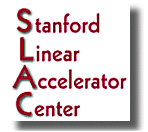on Scientific
Applications
of the LCLS
January 12-14, 1999
Co-chairs:
Ingolf Lindau, SSRL/MAX-Lab
& John Arthur, SSRL/SLAC
For Additional
Information
Contact:
Suzanne Barrett
barrett@ssrl.slac.stanford.edu
SSRL, MS 99
PO Box 4349
Stanford, CA 94309-0210
Phone: (650) 926-3191
Fax: (650) 926-3600
Graphics by
Terry
Anderson
November 9, 1998
Lisa Dunn,
SSRL
This three-day workshop will address novel scientific opportunities using the proposed Linac Coherent Light Source (LCLS), an x-ray free electron laser at the Stanford Linear Accelerator Center. Based on a 15 GeV electron linear accelerator, the LCLS would extend FEL science into the hard x-ray region, providing diffraction-limited, intense, sub-picosecond pulses of radiation in the wavelength range 1.5 - 15 Å. The peak brightness of the LCLS would exceed that of third-generation synchrotron sources by more than ten orders of magnitude. Even with a relatively low pulse repetition rate of 120 Hz, the time-averaged brightness of the LCLS would exceed that of the synchrotron sources by several orders of magnitude. In April 1998, a design study report was completed for the LCLS, including detailed calculations of the properties of its radiation.
The goal of the workshop is to help clarify the most exciting scientific applications of the LCLS, and the necessary scientific development path toward realizing these applications. The performance characteristics presented in the LCLS design study will be used as a basis for the discussion. These characteristics, and a basic review of SASE FEL physics, will be presented at the start of the workshop. Then the workshop will divide into four working groups concentrating on the following areas of science:
- Sub-picosecond time-resolved x-ray measurements
- Non-linear x-ray interactions with matter
- X-ray photon correlation spectroscopy and x-ray holography
- Tests of quantum electrodynamics
Several keynote talks during the course of the workshop will stimulate visionary thinking by reviewing the state of the art of current techniques and future prospects utilizing bright x-ray sources.
The working groups will recombine at the end of the workshop to summarize their conclusions. A further goal of the workshop is to establish working groups that will define the most promising and exciting experiments on LCLS on a continual basis. The scientific concepts for these experiments will be elaborated and integrated with required optics and instrumentation in future workshops.

